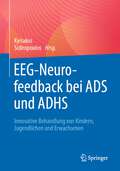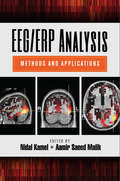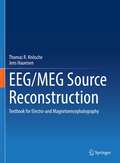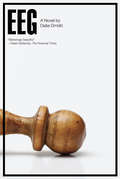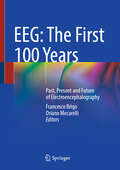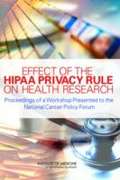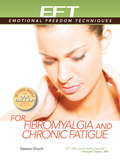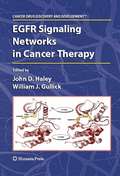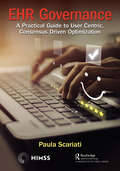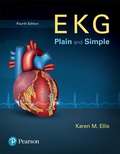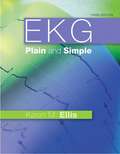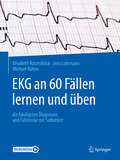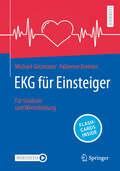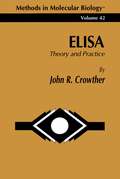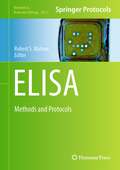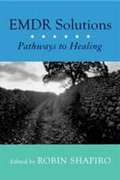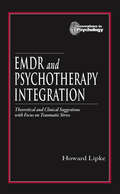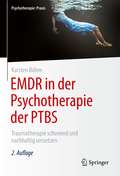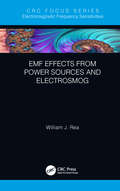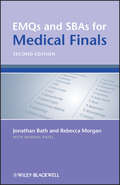- Table View
- List View
EEG-Neurofeedback bei ADS und ADHS: Innovative Behandlung von Kindern, Jugendlichen und Erwachsenen
by Kyriakos SidiropoulosDas Buch ermöglicht Neurowissenschaftlern, Psychotherapeuten, Kinder- und Jugendärzten und -Psychiatern einen Einstieg in die Behandlung von ADS/ADHS mit der Methode des EEG-Neurofeedbacks. Es hilft zudem Ergotherapeuten, die ADHS-Symptomatik besser zu verstehen und die Besonderheiten des EEG-Signals von Kindern, Jugendlichen und Erwachsenen mit ADS/ADHS leichter zu interpretieren. Detailliert stellen die Autoren alle relevanten EEG-Protokolle vor, die in der Praxis Anwendung finden. Beleuchtet werden sowohl die Stärken als auch die Schwächen dieser Methode.
EEG/ERP Analysis: Methods and Applications
by Nidal Kamel Aamir Saeed MalikChanges in the neurological functions of the human brain are often a precursor to numerous degenerative diseases. Advanced EEG systems and other monitoring systems used in preventive diagnostic procedures incorporate innovative features for brain monitoring functions such as real-time automated signal processing techniques and sophisticated amplifi
EEG/MEG Source Reconstruction: Textbook for Electro-and Magnetoencephalography
by Jens Haueisen Thomas R. KnöscheThis textbook provides a comprehensive and didactic introduction from the basics to the current state of the art in the field of EEG/MEG source reconstruction. Reconstructing the generators or sources of electroencephalographic and magnetoencephalographic (EEG/MEG) signals is an important problem in basic neuroscience as well as clinical research and practice. Over the past few decades, an entire theory, together with a whole collection of algorithms and techniques, has developed. In this textbook, the authors provide a unified perspective on a broad range of EEG/MEG source reconstruction methods, with particular emphasis on their respective assumptions about sources, data, head tissues, and sensor properties. An introductory chapter highlights the concept of brain imaging and the particular importance of the neuroelectromagnetic inverse problem. This is followed by an in-depth discussion of neural information processing and brain signal generation and an introduction to the practice of data acquisition. Next, the relevant mathematical models for the sources of EEG and MEG are discussed in detail, followed by the neuroelectromagnetic forward problem, that is, the prediction of EEG or MEG signals from those source models, using biophysical descriptions of the head tissues and the sensors. The main part of this textbook is dedicated to the source reconstruction methods. The authors present a theoretical framework of the neuroelectromagnetic inverse problem, centered on Bayes’ theorem, which then serves as the basis for a detailed description of a large variety of techniques, including dipole fit methods, distributed source reconstruction, spatial filters, and dynamic source reconstruction methods. The final two chapters address the important topic of assessment, including verification and validation of source reconstruction methods, and their actual application to real-world scientific and clinical questions.This book is intended as basic reading for anybody who is engaged with EEG/MEG source reconstruction, be it as a method developer or as a user, including advanced undergraduate students, PhD students, and postdocs in neuroscience, biomedical engineering, and related fields.
EEG: A Novel
by Daša DrndicFinancial Times Book of the Year An urgent new novel about death, war, and memory from the highly acclaimed Croatian writer In this breathtaking final work, Daša Drndic’s fearless voice reaches new heights. Andreas Ban’s suicide attempt has failed. Though very ill, he still finds the will to tap on the glass of history to summon those imprisoned within. Mercilessly, he dissects society and his environment, shunning all favors as he goes after the evils and hidden secrets of our times. History remembers the names of the perpetrators, not the victims—Ban remembers and honors the lost. He travels from Rijeka to Zagreb, from Belgrade to Tirana, from Parisian avenues to Italian castles. Ghosts follow him wherever he goes: chess grandmasters who disappeared during WWII; the lost inhabitants of Latvia; war criminals who found work in the CIA and died peacefully in their beds. Ban’s family is with him too, those already dead and those with one foot in the grave. As if left with only a few pieces in a chess game, Andreas Ban—and Daša Drndic—play a stunning last match against Death. “Daša Drndic was incapable of writing a sentence that was not forceful, fierce or funny-or all three simultaneously.”—Amanda Hopkinson, The Guardian
EEG: Past, Present and Future of Electroencephalography
by Oriano Mecarelli Francesco BrigoAuthored by leading experts, this book explores the key milestones in the 100-year history of the electroencephalogram (EEG). It provides a detailed account of its origins, global development, clinical applications, and lasting impact on neuroscience. By tracing its evolution, the book underscores the EEG&’s enduring relevance. What distinguishes this volume is its dynamic and forward-looking approach. Rather than a traditional historical account, it presents the story of the EEG as an evolving narrative—connecting past discoveries with future possibilities. With advancements in digital technology, machine learning, and artificial intelligence, the EEG remains central to neuroscientific research and a critical diagnostic tool in various medical fields. This book offers valuable insights into the EEG&’s contributions to modern neuroscience and its continued influence. It is intended for neurologists, neuroscientists, neuropsychologists, neurophysiologists, EEG technicians, and medical historians, as well as anyone interested in the development of neuroscience and brain research.
EFFECT OF THE HIPPA PRIVACY RULE ON HEALTH RESEARCH: Proceedings of a Workshop Presented to the National Cancer Policy Forum
by Institute of Medicine of the National AcademiesThe National Academies Press (NAP)--publisher for the National Academies--publishes more than 200 books a year offering the most authoritative views, definitive information, and groundbreaking recommendations on a wide range of topics in science, engineering, and health. Our books are unique in that they are authored by the nation's leading experts in every scientific field.
EFT for Fibromyalgia
by Dawson ChurchEFT is a breakthrough treatment for fibromyalgia, chronic fatigue, and similar conditions. This book is packed with heartbreaking stories by former sufferers, talking about the pain, despair, and limitation they lived through before finding EFT. After EFT, many report complete or partial remission, even though fibromyalgia and chronic fatigue are labeled "incurable" by the US National Institutes of Health and many medical professionals. This book will teach you the steps of the method they used. It's called "Clinical EFT" because it has been validated in dozens of clincal trials, including one showing that fibromyalgia sufferers experienced much less pain, anxiety and depression after learning EFT, with many recovering completely. The reason for EFTs remarkable results is that it reduces stress, especially stress associated with negative emotions such as anger, guilt, grief, shame and blame. This book will guide you into identifying the traumatic experiences that contribute to stress, and tapping away their emotional charge. Imagine: no drugs, surgery, or demanding treatment regimens; just the powerful medicine of emotional healing, stress reduction, and inner peace.
EGFR Signaling Networks in Cancer Therapy
by William John Gullick John D. HaleyThe epidermal growth factor (EGF) receptor and its downstream signal transduction networks have been implicated in the ontology and maintenance of tumor tissues, which has motivated the discovery and development of molecularly targeted anti-EGFR therapies. Edited by John Haley and William J. Gullick, EGFR Signaling Networks in Cancer Therapy, is separated into two sections. The first of which probes the molecular pathways and the intersection of signaling networks which are frequently deregulated in human cancers, with a view to describing EGF receptor in a tumor tissue specific context. Meanwhile, the second section illustrates the many ways in which EGF receptor contribute to abnormal survival and migration signaling in cancer cells and to epithelial to mesenchymal transition and metastasis. The book also describes the mitogenic, survival, adhesive and migratory pathways within a framework of interacting subsystems that contribute to the activity and physiological regulation of the receptor in normal and neoplastic tissues. Even though there is still much to learn, this volume explores this fascinating system with compelling information.
EGFR-Directed Therapy in Lung Cancer (Elements in Molecular Oncology)
by So Yeon Kim Daniel B. Costa Daisuke Shibahara Susumu Kobayashi Balazs HalmosEpidermal growth factor receptor (EGFR)-mutant non-small cell lung cancer (NSCLC) is a clinically important driver alteration affecting approximately one-third of lung cancer patients. Treatments for EGFR-exon 19 deletion and exon 21 L858R NSCLC have evolved over the last decade from first-generation reversible tyrosine kinase inhibitors (TKI) to third-generation irreversible TKIs, of which osimertinib has been the widely accepted as first-line therapy. Despite survival improvement seen with osimertinib and its efficacy against acquired T790M mutation, resistance through on-target and off-target pathways eventually develop. This Element describes the structural biology and pathophysiology of EGFR-mutant NSCLC and discusses past, current, and future treatment options in the metastatic, neoadjuvant, and adjuvant settings. It describes the biology and recently approved treatment for EGFR-exon 20 insertion mutation and the treatment for the uncommon exon 18 (G719X), 20 (S768I), and 21 (L861Q) mutations. It also outlines the promising clinical applications of circulating tumor DNA (ctDNA).
EHR Governance: A Practical Guide to User Centric, Consensus Driven Optimization (HIMSS Book Series)
by Paula ScariatiOrganizations spend large amounts of money to purchase, deploy, and optimize their Electronic Health Records (EHRs). They are not plug-n-play systems so a commitment to an ongoing improvement cycle is necessary. When done well, this responds to the people, the process, and the technology. When not done well, complete failure of the system could result in costing the organization thousands of dollars. Based on the foundational premise that EHR governance done right speeds up change and leads to a positive user experience, this book draws upon more than a decade of work with government, academic, and nonprofit organizations using Epic, Allscripts, McKesson, Meditech, and Cerner. Designed to be practical and pragmatic, it outlines a strategic process that can scale to small and large organizations alike. It begins with how to articulate a clear vision to organizational leaders so they can champion strong EHR governance both theoretically and financially. It then walks through each step required for leading successful change, calling out critical lessons learned to help the reader avoid pitfalls and achieve measurable improvement more rapidly. It concludes with a commitment to ongoing growth and refinement through benchmarked metrics, innovation, and out-of-the-box thinking.
EIDETIC IMAGERY and Typological Methods of Investigation: Their Importance for the Psychology of Childhood, the Theory of (International Library Of Psychology Ser.)
by Jaensch, E RFirst published in 1999. Routledge is an imprint of Taylor & Francis, an informa company.
EKG Plain and Simple (Fourth Edition)
by Karen M. EllisCovering basic to advanced EKG concepts, EKG Plain and Simple puts the student at the patient’s bedside by focusing not just on identifying rhythms or EKGs, but also on what can be done for the patient. <P><P> Part I progresses seamlessly from basic cardiac A&P through waves and complexes, lead morphology, and rhythms. <P>Part II covers 12-lead interpretation, axis, hypertrophy, myocardial infarction, and more. <P>The author provides many clinical scenarios, anecdotes, and critical-thinking exercises, plus over 500 practice rhythm strips and 12-lead EKGs.
EKG Plain and Simple (Third Edition)
by Karen M. EllisUnlike books that encourage rote memorization, this conversationally-written text puts the student at the patient’s bedside, focusing not just on identifying rhythms or EKGs, but also on “Now what do I do for the patient?” Assuming no prior knowledge, EKG PLAIN AND SIMPLE, 3/e covers EKG from basic to advanced concepts. Part I progresses seamlessly from basic cardiac A&P through waves and complexes, lead morphology, and rhythms. Part II covers 12-lead interpretation, axis, hypertrophy, myocardial infarction, and more. The text presents many clinical scenarios, anecdotes, and critical thinking exercises, plus hundreds of practice rhythm strips and 12-lead EKGs. This edition adds new scenarios, chapter notes, and tables; more medication information; and new coverage ranging from MI symptoms to hemiblocks.
EKG Teaching Rounds: A Case-Based Guide
by Lloyd Tannenbaum Rachel E. Bridwell Brannon L. InmanThis book is a short-form guide designed to fill a training gap in medical education. It is a reference that will help interns and junior residents understand and appropriately respond to real world situations that they will be encountering as newly minted physicians. The book outlines a basic methodology for electrocardiogram (EKG) interpretation and sets a framework for the junior resident physician to use to approach every EKG. It describes common dysrhythmias that residents will often encounter, on the wards, in the emergency department, and in clinic. It uses many high-quality images to prime junior learners in the interpretation and recognition of high yield EKGs.Chapters address commonly encountered pathology, such as atrio-ventricular blocks, tachydysrhythmias, acute coronary syndrome, and syncope. The conversational tone of this book is designed to mimic how staff physicians talk to senior medical students and junior residents, maximizing readability to enhance retention.EKG Teaching Rounds is a case-based book that will quickly become an essential reference text for medical professionals in training who are looking to advance their knowledge of EKG interpretation. This book is relevant for every medical specialty and every level of medical education.
EKG an 60 Fällen lernen und üben: die häufigsten Diagnosen und Fallstricke mit Selbsttest
by Elisabeth Ratzenböck Jens Lohrmann Michael KühneSie müssen regelmäßig EKGs beurteilen, fühlen sich aber nicht gut dabei? Egal, ob Sie als Assistenzarzt in der Inneren Medizin noch unsicher sind, Sie als nicht-internistischer Notarzt nur "Zacken" verstehen oder Sie als Hausarzt ihr EKG-Wissen schnell auffrischen möchten: Dieses Buch ist für Sie da. Eine Notfallmedizinerin und zwei Kardiologen mit langjähriger klinischer Erfahrung erklären anhand 60 "echter" EKG-Kurven, worauf es bei der Beurteilung ankommt und welche Fehler Sie vermeiden sollten. Die EKGs sind auf einer Seite unkommentiert, damit Sie ihren aktuellen Wissensstand überprüfen können und auf der nächsten Seite mit der richtigen Diagnose und Erklärungen versehen. Zusätzlich wird das jeweils aus der EKG-Auswertung resultierende erforderliche Procedere beschrieben. So gewinnen Sie Routine und Sicherheit.
EKG für Einsteiger: Für Studium und Weiterbildung
by Michael Gotzmann Fabienne KreimerDieses Buch hilft Ihnen zu einer sicheren und korrekten Befundung sowie Bewertung von EKGs. Anhand von realen Fallbeispielen und etwa 200 Original-EKGs lernen Sie in 16 Kapiteln schrittweise die typischen pathologischen EKG-Veränderungen kennen, z.B. bei Herzinfarkt, bradykarden und tachykarden Herzrhythmusstörungen oder bei strukturellen Herzerkrankungen. Klinische Exkurse erklären die Relevanz der EKG-Veränderungen und Fragen und Antworten dienen zur Wissensüberprüfung. Zahlreiche EKG-Übungen mit Lösungen am Buchende helfen, das Gelernte zu vertiefen. Besonderes Plus: Über die SN Flashcard App stehen 180 Übungs-EKGs zu jeder Zeit und an jedem Ort zum Lernen zur Verfügung. Das Buch berücksichtigt die Anforderungen eines schnellen und praktischen Zugangs zum Thema, aber auch die notwendige Breite und Tiefe, die komplexe EKGs erfordern. Es wendet sich an Studierende der Medizin sowie an alle Assistenzärztinnen und Assistenzärzte, die EKGs befunden müssen, z.B. in der Kardiologie, Inneren Medizin, Allgemeinmedizin, Intensivmedizin und Notfallmedizin.
ELISA
by John R. CrowtherELISA: Theory and Practice introduces to scientists at all levels of expertise the principles of the most commonly used assay technique known as the Enzyme Linked Immunosorbent Assay. The book provides readers with full descriptions of the basic systems that make ELISA one of the most powerful techniques in science today, and also examines in detail the data obtained by ELISA and their analysis and actual manipulation. ELISA: Theory and Practice is designed not only to train novices in the science of ELISA, but also to aid investigators experienced in any of the biological sciences in performing independently assays of antibodies and antigens. Mastery of the book's contents will allow readers to fully appreciate exactly how and why assays function, as well as permit the efficient development of individual assays that are both rapid and accurate.
ELISA: Methods and Protocols (Methods in Molecular Biology #2612)
by Robert S. MatsonThis volume provides an understanding of how an immunoassay works, detailing the strengths, weaknesses, pitfalls. Chapters guide readers on how and when to appropriately utilize this powerful tool, examples of where the ELISA or similar immunoassay formats are currently being used, and newer techniques that may have a significant impact on future applications. Written in the format of the highly successful Methods in Molecular Biology series, each chapter includes an introduction to the topic, lists necessary materials and reagents, includes tips on troubleshooting and known pitfalls, and step-by-step, readily reproducible protocols. Authoritative and cutting-edge, ELISA: Methods and Protocols is a valuable resource for both novice and expert scientists in this developing field.
EMDR Solutions: Pathways To Healing
by Robin ShapiroPractical therapeutic strategies and clinical insights from EMDR practitioners who serve diverse clinical populations. In EMDR Solutions you will find fifteen exemplary EMDR solutions, each of which develops the Standard Protocol in creative and highly effective ways. These solutions move EMDR forward and expand the application of this powerful therapeutic approach. In this source book of therapeutic strategy and clinical insight, each chapter presents step-by-step instructions for implementing a particular EMDR solution with clients. Each intervention is enriched with relevant case histories that bring to life new targets for and variations on the standard EMDR protocol. Concrete and specific, the clinical work illustrated here will add to you fund of knowledge and broaden your practice. Robin Shapiro has gathered a stellar group of EMDR practitioners. Each of the contributors offers key therapeutic insights in an easy-to-digest form: - Maureen Kitchur presents her Strategic Developmental Model, a meta-model for EMDR practice that encompasses all phases of the Standard Protocol, Ericksonian utilization language, and attachment-enhancing practices. Kitchur's model gives a clear order for EMDR processing and a way to process wordless or implicit experience. - Roy Kiessling offers his Resource Development strategies. Easy to learn and very helpful for clients who are disorganized or in crisis, Kiessling's methods turn resources into cognitive interweaves and ego states into resources. - Sandra Wilson and Robert Tinker demonstrate an effective treatment for phantom limb pain that encompasses treatment from history taking through processing to "It's gone!" - A. J. Popky turns the Subjective Units of Distress scale (SUDS) on its head by targeting inappropriate positive affect. Popky also shares his DeTUR protocol with its Level of Urge to Use (LOUU) for the treatment of addictions and compulsive behavior. - Jim Knipe builds on Popky's work with the SUDS and presents techniques for clearing love-sickness, procrastination, avoidance and codependence using the Level of Urge to Avoid (LOUA). - Joanne Twombly and Ulrich Lanius teach two very different preparations for doing EMDR with people with dissociative disorders. Twombly's applies techniques derived from hypnosis and ego-state work while Lanius shows how to use opiate-inhibiting medication to allow EMDR to work with dissociated clients. - Robin Shapiro addresses the Two-Hand Interweave, a simple but widely applicable exercise of discernment. Shapiro also contributes chapters on using EMDR with anxiety disorders, in differentiation-based couple's therapy and with generational and cultural introjects. - Elizabeth Turner engages children with art therapy, play therapy, and story telling in all phases of EMDR. Her chapter is the delightful cherry on top of this informative, easy-to-use book. Additional chapters by Carole Lovell, Andrew Seubert, Jim Cole, and Susan Schulherr address EMDR with dialectical behavior therapy (DBT) with borderline clients, working with mentally retarded clients, a reenactment tool from guided imagery, and the binge/starve cycle of eating disorders. Whether you read EMDR Solutions cover-to-cover or peruse one chapter that speaks to a particular technique or client population, you will be adding crucial skills and knowledge to your EMDR toolbox.
EMDR Solutions: Pathways to Healing
by Robin ShapiroIn EMDR Solutions you will find fifteen exemplary EMDR solutions, each of which develops the Standard Protocol in creative and highly effective ways. These solutions move EMDR forward and expand the application of this powerful therapeutic approach. In this source book of therapeutic strategy and clinical insight, each chapter presents step-by-step instructions for implementing a particular EMDR solution with clients. Each intervention is enriched with relevant case histories that bring to life new targets for and variations on the standard EMDR protocol. Concrete and specific, the clinical work illustrated here will add to you fund of knowledge and broaden your practice.
EMDR and Psychotherapy Integration: Theoretical and Clinical Suggestions with Focus on Traumatic Stress (Innovations in Psychology Series)
by Howard LipkeInitially regarded as one of the most peculiar methods of psychotherapy ever devised, EMDR (eye movement desensitization and reprocessing) was introduced to psychotherapists 11 years ago when Dr. Francine Shapiro reported demonstrable rapidly effective treatment results. An early endorsement by the late Dr. Joseph Wolpe, a founder of behavior thera
EMDR in der Psychotherapie der PTBS: Traumatherapie schonend und nachhaltig umsetzen (Psychotherapie: Praxis)
by Karsten BöhmDieses Buch zeigt, wie psychologische und ärztliche Psychotherapeuten EMDR in der Traumatherapie einsetzen können. Die Psychotherapie der Posttraumatischen Belastungsstörung (PTSD, PTBS) konfrontiert Patienten mit grausamen und oft schwer zu ertragenden Bildern und Erinnerungen, um ihnen die Verarbeitung dieser Erlebnisse zu ermöglichen. Patienten sagen dabei, dass sie sich leicht auf EMDR einlassen können – es gerne anwenden. Forschung und Praxis bestätigen, dass Therapieabbrecher bei EMDR selten sind. Die WHO hat EMDR längst anerkannt. Fachleute erfahren in diesem Buch, wie sie EMDR in ihre Therapie integrativ einbauen können und welche Besonderheiten zu berücksichtigen sind – auch bei komplexen Fällen und bestehenden Komorbiditäten. Dabei liegt der Schwerpunkt auf der Anwendung – Fallbeispiele verdeutlichen die komplexe EMDR-Therapie, der Text ist leicht verständlich aufgebaut. Mit einem Geleitwort von Dr. Arne Hofmann. Geschrieben für … … Psychologische Psychotherapeuten (sowohl verhaltenstherapeutisch als auch tiefenpsychologisch orientiert), Traumatherapeuten, Ärzte, Psychotherapeuten in der Ausbildung. Der Autor: Dr. phil. Dipl.-Psych. Karsten Böhm, Trainer und Supervisor für EMDR und Verhaltenstherapie; Leitender Psychologe an der Klinik Friedenweiler im Schwarzwald und 1. Vorsitzender von EMDRIA Deutschland.
EMF Effects from Power Sources and Electrosmog (Electromagnetic Frequency Sensitivities)
by William J. ReaThe field of electromagnetic sensitivity is the new epidemic of the 21st century, and can cause disease of the automatic nerve system in any part of the body. This is as a result of chemical sensitivity, in which over 80,000 chemicals are involved, resulting in innumerable combinations. A cursory understanding of the combinations can help clinicians partially understand the associated problems and thus help in the diagnosis and treatment of electromagnetic sensitivities. But a basic understanding of environmentally induced illness and healing must first be understood by the clinicians before diseases occur such as cardiac arrhythmia, muscle spasms, and nerve pain. Key Features: Describes how an understanding of the vast combinations of electrical and chemical sensitivities will help in the diagnosis and treatment of electromagnetic sensitivities Reveals the complexity and multi-faceted presentation often seen in chemical sensitivity and chronic degenerative disease cases Provides information backed up by rigorous scientific data including hundreds of tables and figures as online resources Features a Dedication to Robert Becker, MD, an orthopedic surgeon who was one of the first clinicians to recognize the significance of EMF in medicine and surgery, and also to his assistant Andrew Marino, PhD, who helped develop the basic science of orthopedic electromagnet healing
EMQs and SBAs for Medical Finals
by Rebecca Morgan Jonathan Bath Mehool PatelPrepare for final and penultimate-year exams with EMQs and SBAs for Medical FinalsFive complete practice question papers for realistic preparationEach question paper contains 60 Single Best Answer questions and 30 Extended Matching QuestionsIncludes topic index so that readers can target problem areasDetailed explanation of the knowledge behind both correct and incorrect answersEMQs and SBAs for Medical Finals is perfect for the student looking to test their knowledge and identify weak subject areas. Practice questions cover all key topics in medicine, with the subject balance reflecting the weighting in real exams. For this edition, all content has been updated and focused to remain relevant for today's finalists and the exams they will face. Inclusion of the topic index means that the title allows for both wide-ranging and focused revision. All in all, an essential resource for anyone facing their final medical exams.
EMQs for MRCOG Part 2: A Self-Assesment Guide
by Kalaivani Ramalingam Jeremy Brockelsby Christian Phillips Latha PalaniveluThis book provides those studying for the MRCOG Part 2 examination with welcome practice in answering the newly introduced EMQ style of question. Modelled on the current MRCOG syllabus, the book is designed to test the candidate's theoretical and practical knowledge of obstetrics and gynaecology.The book opens with an introductory section, explaining the EMQ and its place in the examination, and advising candidates on how they should approach this question type to obtain the highest marks. This is followed by a collection of 71 EMQ themes, with a total of 291 questions for the reader to attempt. The questions are based on common clinical scenarios and cover a variety of topics. Answers are included after each topic, and these include explanatory material and useful references.With a concentration on the core areas of the syllabus and a wide and varied selection of practice EMQs, this book will be an invaluable addition to the bookshelves of all candidates in preparation for the MRCOG Part 2.
